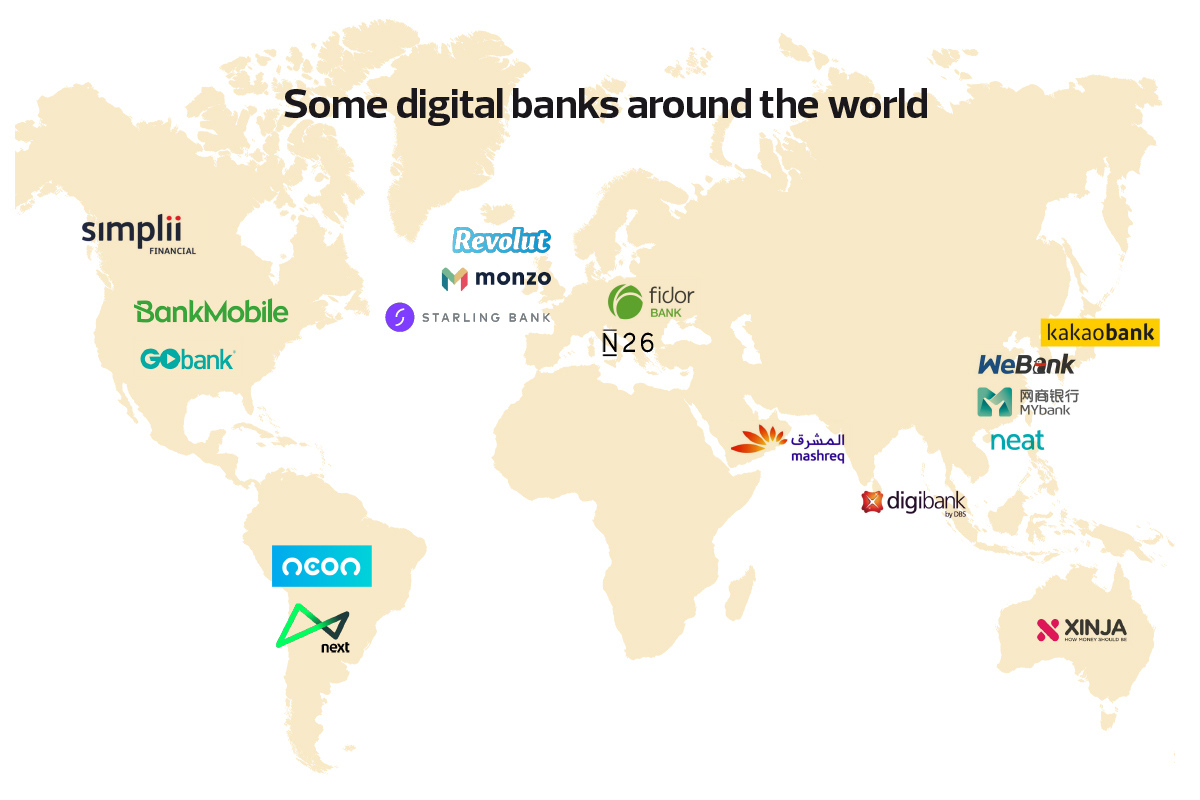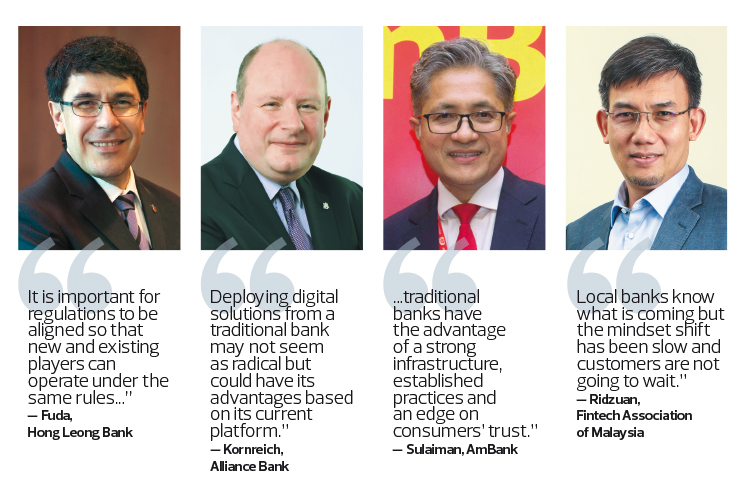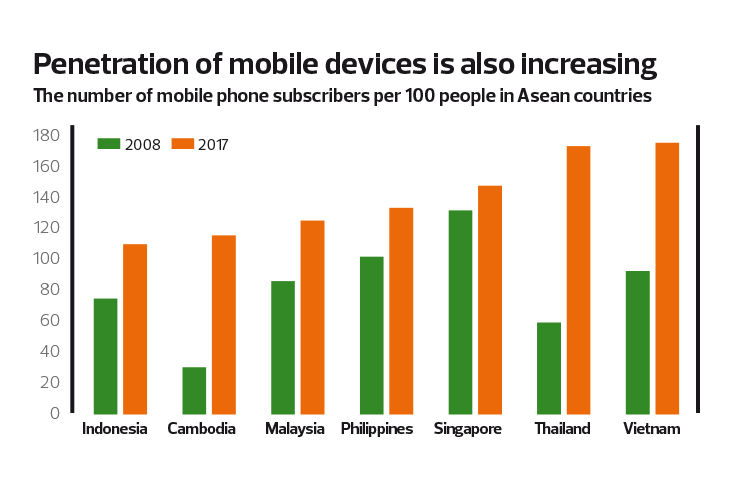This article first appeared in The Edge Malaysia Weekly, on June 24, 2019 - June 30, 2019.
Click / Tap image to enlarge






IT’S inevitable — digital banks are coming. This new breed of banks has been sprouting up in the region, particularly in China, and it is only a matter of time before they come to Malaysia’s shores.
A digital bank, sometimes known as a virtual bank, is one that does not have a physical presence but delivers products and services online or through mobile platforms. They include DBS Group’s digibank and Tencent’s WeBank.
Bank Negara Malaysia has already said it aims to come out with virtual bank licensing requirements by the end of the year.
While the industry waits with bated breath for the licensing criteria, what is certain is that both banks and technology firms are eyeing the licences.
Regional tech giant Grab and at least four of seven banks that responded to questions from The Edge have indicated that they are interested (see “Grab and four banks keen on digital banking licence” on Page 64).
Ultimately, all eyes are on what Bank Negara’s guidelines will entail. Will the digital banking playground be open to all or limited to just tech companies? Will digital banks operate on a level playing field as traditional banks? Will the same regulations apply to both?
Bank Negara tells The Edge that it is finalising its review of the licensing and regulatory requirements for the establishment of digital banks in Malaysia. “Since the bank’s announcement, several new players have registered interest with the bank as well as their views on an enabling regulatory ecosystem,” it says.
“The appropriate number of licences in Malaysia ultimately depends on the banking system’s market structure and depth, and the applicant’s ability to fulfil the prudential and best interest of Malaysia, as stipulated in the Financial Services Act 2013 and Islamic Financial Services Act 2013.”
Last Wednesday, a Bank Negara official revealed that more than 10 parties have expressed interest in setting up digital banks in the country.
So far this year, Hong Kong’s banking regulator has issued eight virtual banking licences. And, early last month, the Monetary Authority of Singapore announced that it is considering allowing virtual banks with non-bank parentage to operate in the city state.
Level playing field?
In recent years, incumbent banks have had to grapple with diminishing return on equity and rising regulatory costs.
Now, they have to contend with a new breed of competitors that may not necessarily be subject to the same strict rules.
EY Korea financial services advisory partner Young-Suk Kim says in South Korea, for example, the rules for digital banks are the same as for incumbent banks, except for two things — easier credit card licence approvals and a waiver from having to comply with Basel III rules until two years after launch.
Malayan Banking Bhd (Maybank) group president and CEO Datuk Abdul Farid Alias is of the view that if digital banks are looking to target profitable segments of banking and not take on a corporate responsibility role in serving the underbanked, then they “should be made to operate on a level playing field with traditional banks” — among others, they should be subject to the same capital and liquidity requirements, and should comply with the other regulations such as the know- your-customer rules as well as anti-money laundering and risk management regulations.
“We will still need to understand the parameters under which the digital banks will be allowed to operate and, if there is a level playing field for all, to see the final impact they will have on the local banking industry,” he says.
Regulation is important, says CIMB Group Holdings Bhd group CEO Tengku Datuk Seri Zafrul Aziz, as it protects customers and boosts confidence in banks.
“The trust factor is key for us banks. As it is known, banks are regulated five times more than fintechs. I hope the central banks in the region will consider the landscape. As long as we have a level playing field, it is good as disruption is good for the industry and everyone,” he adds.
Hong Leong Bank Bhd group managing director and CEO Domenic Fuda says it is important for regulations to be aligned so that new entrants and existing players can operate according to the same rules and requirements — creating a level playing field where old and new players can compete effectively.
Reinvent or fail
Without doubt, digital banks will shake up the local banking industry. The key question is, how big a shake-up?
Fintech Association of Malaysia president Mohammad Ridzuan Abdul Aziz believes that local banks will face a great challenge not only from the digital banks but also from consortiums — made up of techfin firms, telcos and entities with large captive customer databases — that may secure digital banking licences.
“We see this trend as an opportunity for [traditional banks] to collaborate with various new types of external entities from non-banking sectors to bring more value to customers. We believe that this direction is inevitable for the traditional banks as the organic development has proved to be slow, costly and has almost no new enticing value for their customers,” he tells The Edge.
Ridzuan opines that banks are at different levels of preparedness to compete with digital banks. “One aspect that is prominent is that the majority of them still believe that they can rapidly embrace the digital banking wave organically, that is, by evolving from within with their digital transformation plan.”
But he believes the organic transformation that banks are undertaking will not be fast enough compared with the progress made by digital banks.
Ridzuan says local banks know what is coming but the “mindset shift has been slow and customers are not going to wait”.
“There are local banks that are relatively hungrier, more eager and bolder in embracing the digital banking challenges. However, we have not seen credible efforts being made towards approaching them differently (for example, forming consortiums and setting up joint ventures with foreign digital banks) and many are still struggling to fathom the concept of digital banking to initiate their internal digital transformation journey.”
According to the EY Global Fintech Adoption Index 2019, nearly two-thirds of consumers in Asia-Pacific are active users of fintech products and services.
“Among the 196 fintech players established in Malaysia last year, payments, e-wallets, peer-to-peer lending and micro-insurance are some of the areas being highly disrupted in the fintech space. Diversity in the market has also broadened with the entry of global fintech companies into Malaysia, such as Alipay (China), WeChat Pay (China), TransferWise (the UK), WorldRemit (the UK) and MoneyLion (the US), and the latest announcement of the virtual bank licences is expected to further open doors to international players,” says Shankar Kanabiran, an advisory services partner at EY Malaysia.
Is the fast-changing landscape the beginning of the end for incumbent banks?
EY Korea’s Kim does not think so. However, he stresses that incumbent banks need to innovate to survive as their relatively high cost structure will make it harder for them to compete.
He gives the example of Kakao Bank, a digital bank in South Korea that has gained much traction since it started in July 2017, garnering a whopping eight million customers in just 1½ years. Even so, it has a marginal market share despite its popularity.
“This means incumbent banks have a different role from the digital banks. From a product perspective, they are doing the same, but consumers have different expectations from incumbent banks and digital banks,” he says.
Given this, Kim believes there is a chance for incumbent banks to provide a different value proposition to consumers in this new banking reality.
Banks not in denial
Malaysian banks contacted by The Edge are conscious of the new banking reality. Most say they welcome the development.
Maybank’s Farid is matter-of-fact about it, noting that the local banking industry has no choice but to accept the eventual presence of digital banks as it is only a matter of time before they operate in the local market.
“While we acknowledge that digital banks will disrupt the market and result in greater competition, we do believe that the local banking industry has the ability to rise to the challenge. More so as banks have the advantage of a longer history, the benefit of customers’ trust built over the years and a deep reservoir of data that can help them compete by creating products and services that their customers need,” he says.
“As we have seen, banks have been able to reinvent themselves and adapt to technological changes over the years, and it will definitely be interesting to see how the new digital banks and current banking players operate in this new environment.”
Affin Bank Bhd group CEO Kamarul Ariffin Mohd Jamil expects digital banks to “certainly disrupt” the local banking scene in a “big manner”.
“Digital banks will cause some erosion in terms of market share of the local banking industry, especially in specific areas that digital banks are focusing on. However, this phenomenon will cause traditional banks to fast-track their digital transformation to be more competitive and be on a par with digital banks. Furthermore, we foresee the birth of digital-only banks from the traditional outfits to compete with the influx of digital banks coming into the market. In the medium term, we believe there will be collaboration between traditional and digital banks to complement each other’s strengths and weaknesses,” he says.
RHB Bank Bhd group managing director Datuk Khairussaleh Ramli believes digital banks will emerge in Malaysia “sooner rather than later” in line with global trends and will make the domestic financial services market more robust and dynamic.
“Banks in Malaysia have been competing with fintechs and non-banking players, with customers being the main beneficiaries in the last few years. We believe that the Malaysian market has a strong pull factor for digital banking, given the high mobile penetration, digitally savvy customer base and an attractive marketplace,” he says.
CIMB’s Zafrul points out that digitalisation is key to financial inclusion and this should bode well for society as a whole.
“Conventional banks are already dealing with disruptions daily. These types of digital or virtual banks will form another class of disrupters. First and foremost, we are continuously innovating [our] ‘traditional’ bank to serve customers better. We feel that there will always be a space for it,” he says.
The emergence of digital banks in the system is something banks should fear but welcome at the same time, says AmBank group CEO Datuk Sulaiman Mohd Tahir.
“In this era of digital disruption, banks certainly cannot rest on their laurels but continue to reinvent themselves and evolve more dynamically. We need to continue to change and move beyond traditional banking,” he says.
Hong Leong Bank’s Fuda believes that the entry of new banking players will further accelerate the development of current digital offerings by traditional banks for the benefit of consumers and business customers.
“The impact of digital banks will manifest itself predominantly in eliminating current pain points in delivering banking services to individuals and SMEs (small and medium enterprises). Delivery of such products and services is likely to take place much more efficiently and without the need for physical interaction, impacting the way services are offered and transactions are performed,” he says.
A pure digital bank may have cost advantages, but it will take time to set up, and the process of providing a total digital experience will face roadblocks, says Alliance Bank Malaysia Bhd group CEO Joel Kornreich.
“In addition, it will need to incur significant marketing expenses to scale up. Deploying digital solutions by a traditional bank may not seem radical but could have its advantages, based on its current platform. Combining the experience of having deployed a digital bank in other markets with local partners to access large client bases could be a threat. We are focused on getting there quickly as well,” he adds.
The biggest challenge for banks today is changing the mindset of their people, says Zafrul.
“The culture and DNA of banks need to be changed. Technology is out there — we can adopt it and come up with the right strategies, but if the mindset is not there and people are not willing to change from within, then the banks will never be successful and they will not be able to compete in the new banking landscape,” he adds.
Henry Ma, vice-president and chief information officer of WeBank, concurs.
“Building the right culture is very important. Do more bottom-up innovation. In this generation, we have to let the young people innovate and participate in the process. Even if they fail ... failing at a reasonable cost is much better than letting them sit there doing nothing. That is the kind of mentality and culture we are trying to nurture at WeBank. So far, we’ve seen good results. Most of the products in the market are by our junior to mid-level staff,” he says, adding that products should be kept simple.
“If banks want to be more competitive in the fintech space, then they must do less outsourcing. You have to build up your technical capabilities. In our case, we built our own engineering team. You need to have that engineering culture. Make sure that technology is one of your core competencies.”
AmBank’s Sulaiman sums it up: “The new digital banks may be more innovative and agile with cutting-edge customer experience, but traditional banks have the advantage of a strong infrastructure, established practices and an edge on consumers’ trust. Ultimately, customers will decide on who wins.”
https://www.theedgemarkets.com/source/theedgemarkets.com
